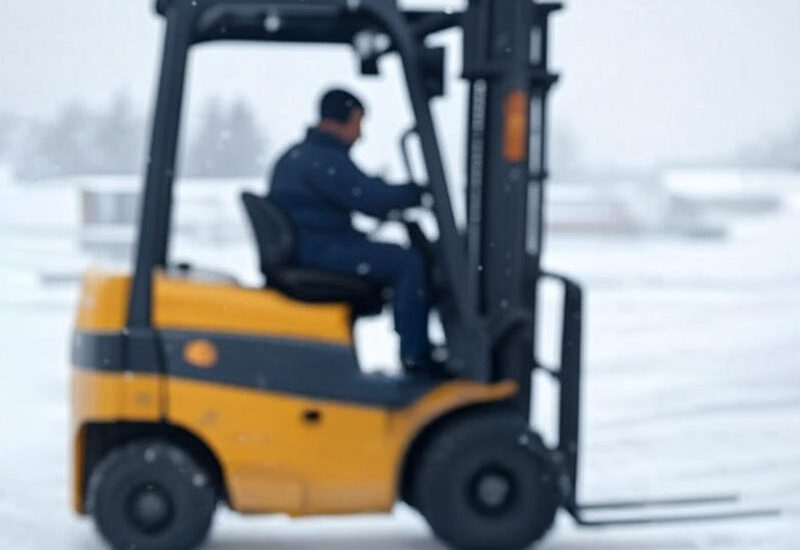Winter operations present unique challenges for forklift fleets, testing equipment limits and requiring specialized preparation to maintain productivity and safety. As temperatures drop below freezing, standard operating procedures become inadequate, and equipment designed for moderate climates can experience significant performance degradation or complete failure. Understanding cold weather impacts and implementing comprehensive winterization strategies ensures reliable operation throughout the harshest months.
Low-Temperature Performance Challenges
Cold weather affects every aspect of forklift operation, from basic starting procedures to load handling capabilities. Engine performance degrades as oil viscosity increases and combustion efficiency decreases. Diesel engines face particular challenges with fuel gelling and reduced compression ratios in extreme cold. Even electric forklifts experience dramatic performance reductions as battery chemistry becomes less efficient at low temperatures.
Hydraulic systems suffer significantly in cold conditions. Thick, cold hydraulic fluid creates increased pump loads and slower response times. Seals become brittle and may leak or fail completely. Lift speeds decrease noticeably, and precise control becomes difficult as the hydraulic system struggles to maintain consistent pressure and flow rates.
Material handling becomes more hazardous as loads may be frozen together, creating unexpected weight distributions or sudden load shifts when items separate during transport. Pallets become brittle and prone to breakage, while some materials change characteristics dramatically in cold conditions.
Battery Heating Systems
Electric forklift performance depends heavily on battery temperature management. Lead-acid batteries lose approximately 50% of their capacity at 0°F compared to their rated capacity at 80°F. Lithium-ion batteries perform better but still experience significant capacity reduction in extreme cold.
Battery heating systems address these challenges through various approaches. Immersion heaters warm electrolyte directly in lead-acid batteries, while thermal blankets provide external warming for both lead-acid and lithium-ion systems. More sophisticated systems include thermostatic controls that automatically maintain optimal operating temperatures without overheating.
Charging procedures require modification in cold weather. Cold batteries accept charge more slowly and may require longer charging cycles. Some systems incorporate pre-heating phases that warm batteries before beginning the charge cycle, improving both charging efficiency and battery life. Heated charging areas provide the ideal solution, maintaining batteries at optimal temperatures throughout the charging process.
Battery maintenance becomes more critical in winter. Water levels in lead-acid batteries should be checked more frequently, as cold weather can affect electrolyte specific gravity. Terminal corrosion accelerates in cold, wet conditions, requiring more frequent cleaning and protection.
Hydraulic Fluid Considerations
Hydraulic fluid selection proves critical for cold weather operation. Standard hydraulic fluids become thick and sluggish in cold temperatures, causing pump cavitation and system damage. Multi-grade hydraulic fluids maintain better viscosity characteristics across temperature ranges, while specialized cold-weather formulations operate effectively to -40°F or lower.
Fluid warming systems help maintain optimal operating temperatures. Engine-mounted heat exchangers use engine coolant to warm hydraulic fluid, while electric heaters provide warming for electric forklifts. Some systems include thermostatic controls that activate heating only when needed, conserving energy while protecting system components.
Water contamination becomes especially problematic in winter as moisture can freeze within hydraulic lines, causing blockages and component damage. More frequent fluid analysis and filtration may be necessary to prevent ice formation and maintain system integrity.
Operator Cabin Heating Solutions
Operator comfort and safety require effective cabin heating systems that maintain visibility and prevent fatigue. Enclosed cabs with efficient heating systems provide the best protection, using engine coolant for internal combustion forklifts or electric heating elements for battery-powered units.
Heated seats offer targeted comfort while consuming less energy than full cabin heating. Some systems include heated steering wheels and foot warmers for comprehensive operator comfort. Defrosting systems for windows and mirrors ensure clear visibility throughout the shift.
Air circulation becomes critical in enclosed, heated cabs to prevent carbon dioxide buildup and maintain air quality. Proper ventilation systems balance heating efficiency with air quality requirements, particularly important for propane-powered forklifts operating in semi-enclosed spaces.
Ice and Snow Traction Management
Traction management in winter conditions requires both equipment modifications and operational procedure changes. Specialized tires with aggressive tread patterns or studded designs provide improved grip on ice and snow. Tire chains offer maximum traction but may damage indoor floors and require careful selection for specific applications.
Weight distribution becomes more critical on slippery surfaces. Additional counterweight may improve traction but affects lifting capacity and requires load chart adjustments. Sand or salt application helps improve surface conditions but requires careful consideration of environmental impact and cleanup requirements.
Reduced speeds and modified turning techniques prevent loss of control on slippery surfaces. Operators need training on winter driving techniques, including gentle acceleration and braking, wider turning radii, and increased following distances.
Seasonal Maintenance Protocols
Comprehensive winterization requires systematic preparation before cold weather arrives. Engine preparation includes coolant system service with appropriate antifreeze concentrations, battery testing and replacement if necessary, and fuel system preparation including fuel additives or winter-grade fuels.
Pre-winter inspections should focus on components most affected by cold weather. Check heating systems, battery condition, hydraulic fluid quality, and tire condition. Replace worn components before they fail in cold conditions when repairs become more difficult and expensive.
Daily maintenance procedures require modification for winter conditions. Extended warm-up periods allow fluids to reach operating temperatures before full operation begins. More frequent inspections identify problems before they cause failures in harsh conditions.
Storage considerations become important for equipment not in continuous use. Heated storage facilities provide ideal conditions, but when unavailable, proper preparation including fluid changes, battery maintenance, and protective covers helps prevent cold weather damage.
Conclusion
Successful cold weather forklift operations require comprehensive preparation addressing every system affected by low temperatures. From battery heating and hydraulic fluid selection to operator comfort and traction management, each element contributes to safe, efficient winter operation. Organizations that invest in proper winterization procedures maintain productivity while protecting equipment investments and ensuring operator safety throughout the challenging winter months. Planning and preparation remain the keys to successful cold weather material handling operations.

